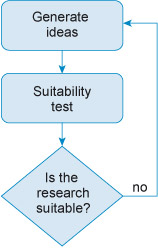2 Getting started
This section explores ways in which ideas for research can be generated and considers the importance of refining research ideas by evaluating their suitability. It ends by looking at how to design a good research question. The aims of this section are to:
- assist you in generating research ideas
- enable you to identify a number of research questions
- encourage you to refine your research questions
- explore common pitfalls in the design of research questions.
As you work through this section you will be asked to identify three possible research questions. You will then explore how you can refine these by evaluating them for their suitability.
When generating research ideas to create a research question it can be helpful to think about topic areas. You could choose a topic: in which you are interested; around which there is current debate; where there are proposals for reform or where there has been recent reform; where the law in one jurisdiction has taken a different approach to the law in other jurisdictions; where a significant precedent has just be set or where there are significant identifiable failings in a system. This approach can assist in your search for a research idea. That idea can then be refined into a research question.
The flow diagram in Figure 2 represents the first three stages of the research selection process explored in this section. This process continues with feasibility and risk analyses which are covered in Section 3.

